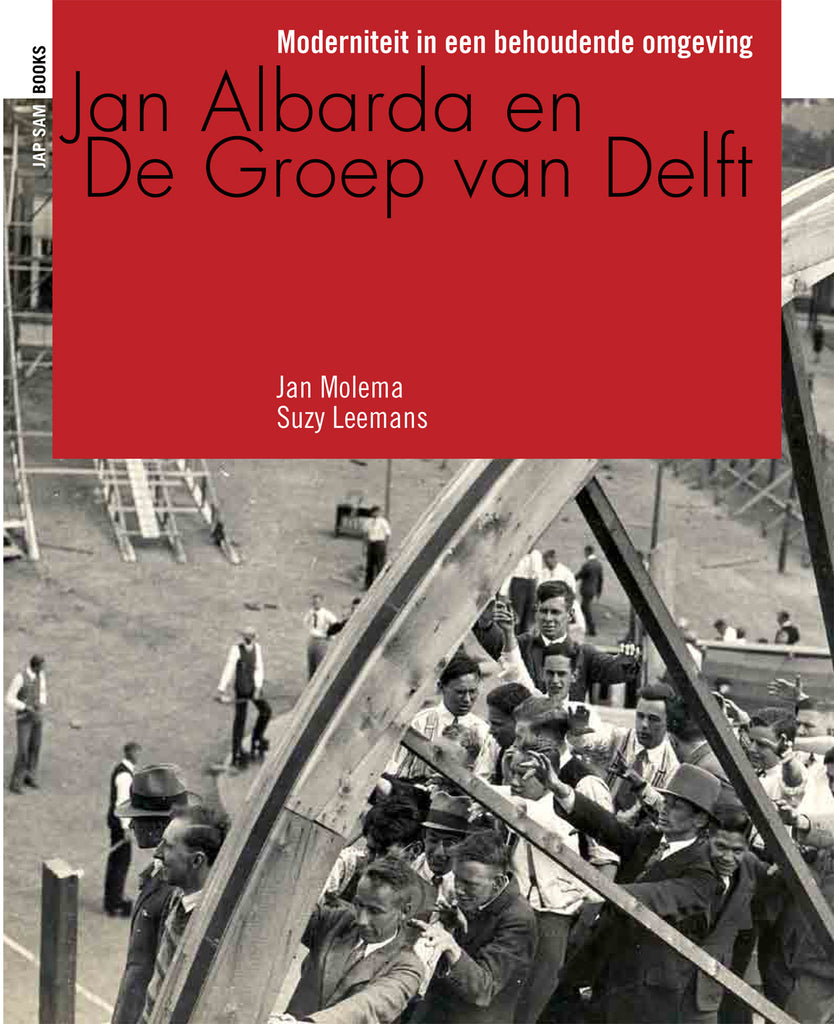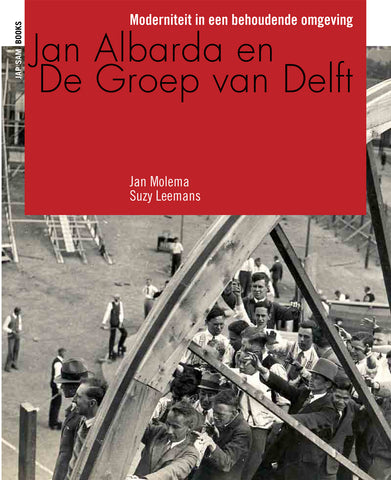Your cart is currently empty!
Theory
Moderniteit in een behoudende omgeving / Modernity in a conservative environment
+++Jan Albarda en De Groep van Delft / Jan Albarda and The Group of Delft+++
+++Jan Molema, SuzyLeemans+++
978-94-90322-17-5
Joseph Plateau grafisch ontwerpers
368
20 x 25 cm
Paperback
Dutch
This publication is supported by the Prins Bernhard Cultuurfonds.
This publication is published in cooperation with STAG.
For more information: De Groep van Delft
In retrospect Delft's Faculty of Architecture of the 1930s is perceived as a dark and introvert period of time when the conservatism of the Delftse School movement inhibited the progressive thinking of earlier years. However, the circumstances are more nuanced; at that time an enthusiastic group of students, who later became known as De Groep (The Group), instigated and provoked discussion about the state of architecture. As well as Granpré Moliere – later considered the leader of the Delftse School – other key figures of 'new architecture' also took part, such as; Gropius, Breuer, Le Corbusier, Lurçat, Duiker, Rietveld, Oud and Van Eesteren.
While the members of De Groep were still students, three events took place which motivated the discussion. In 1928 the open air play D.16.M.M. (Mensch en Machine) was staged in order to celebrate the 16th anniversary of the Delftsch Studenten Corps. Progressive artists who took part included the writer Mannus Franken, composer Leo Smit, director Albert Van Dalsum and the filmmaker Joris Ivens. The open air play made a big impact upon the students and formed the basis for their ensuing search for a better society.
Some of the members of De Groep have led a remarkable life. After graduating they began their careers by working with eminent architects such as Oud, Van Tijen and Rietveld. However, the economic crisis, followed by World War II, badly affected their promising careers as self employed architects / urban planners. The members who survived the war returned to play their part in the post war reconstruction, but until now there has been very little attention paid to their role. It is justified to say that they have paved the way for subsequent generations of architects and urban developers like Van den Broek, Bakema, Van Eyck and Hertzberger, who have become internationally prominent because of their reverence for Modernity. Some members of De Groep have asserted their influence in other parts of the world, like Jan Albarda, Huibert van Doorninck and Kees Bakker who emigrated to Canada.
In 1930 the Internationale Leergang voor Nieuwe Architectuur (International Congress for New Architecture) took place on the 1st, 2nd and 3rd December, which was organized by Practische Studie, the society for architecture students in Delft at that time, with Joost Boks, Henk Jan Brusse and Jan Horatius Albarda on the committee. Although this gathering was not formally supported by the Faculty of Architecture, it brought together the top architects of a recently formed CIAM (Congrès Internationaux d'Architecture Moderne), who had just held their third conference in Brussels. On the 3rd of April 1933 Henk Jan Brusse gave a lecture entitled 'Wat Wij Willen' ('What We Want') in order to honour the founding of De Groep. During this lecture he called for more scope for renewal which, according to the De Groep, remained lacking within the faculty's study programme.
Jan Albarda en De Groep van Delft / Jan Albarda and The Group of Delft
€38.50
Moderniteit in een behoudende omgeving / Modernity in a conservative environment
Jan Albarda en De Groep van Delft / Jan Albarda and The Group of Delft
€38.50
978-94-90322-17-5
Joseph Plateau grafisch ontwerpers
368
20 x 25 cm
Paperback
Dutch
This publication is supported by the Prins Bernhard Cultuurfonds.
This publication is published in cooperation with STAG.
For more information: De Groep van Delft
In retrospect Delft's Faculty of Architecture of the 1930s is perceived as a dark and introvert period of time when the conservatism of the Delftse School movement inhibited the progressive thinking of earlier years. However, the circumstances are more nuanced; at that time an enthusiastic group of students, who later became known as De Groep (The Group), instigated and provoked discussion about the state of architecture. As well as Granpré Moliere – later considered the leader of the Delftse School – other key figures of 'new architecture' also took part, such as; Gropius, Breuer, Le Corbusier, Lurçat, Duiker, Rietveld, Oud and Van Eesteren.
While the members of De Groep were still students, three events took place which motivated the discussion. In 1928 the open air play D.16.M.M. (Mensch en Machine) was staged in order to celebrate the 16th anniversary of the Delftsch Studenten Corps. Progressive artists who took part included the writer Mannus Franken, composer Leo Smit, director Albert Van Dalsum and the filmmaker Joris Ivens. The open air play made a big impact upon the students and formed the basis for their ensuing search for a better society.
Some of the members of De Groep have led a remarkable life. After graduating they began their careers by working with eminent architects such as Oud, Van Tijen and Rietveld. However, the economic crisis, followed by World War II, badly affected their promising careers as self employed architects / urban planners. The members who survived the war returned to play their part in the post war reconstruction, but until now there has been very little attention paid to their role. It is justified to say that they have paved the way for subsequent generations of architects and urban developers like Van den Broek, Bakema, Van Eyck and Hertzberger, who have become internationally prominent because of their reverence for Modernity. Some members of De Groep have asserted their influence in other parts of the world, like Jan Albarda, Huibert van Doorninck and Kees Bakker who emigrated to Canada.
In 1930 the Internationale Leergang voor Nieuwe Architectuur (International Congress for New Architecture) took place on the 1st, 2nd and 3rd December, which was organized by Practische Studie, the society for architecture students in Delft at that time, with Joost Boks, Henk Jan Brusse and Jan Horatius Albarda on the committee. Although this gathering was not formally supported by the Faculty of Architecture, it brought together the top architects of a recently formed CIAM (Congrès Internationaux d'Architecture Moderne), who had just held their third conference in Brussels. On the 3rd of April 1933 Henk Jan Brusse gave a lecture entitled 'Wat Wij Willen' ('What We Want') in order to honour the founding of De Groep. During this lecture he called for more scope for renewal which, according to the De Groep, remained lacking within the faculty's study programme.



